Chain Link Technique & Balloon History
by Ralph Dewey
This month’s Balloon HQ Challenge is a fancy heart.
At the first Balloon Manor project, I used a chain link technique on several of the characters used in the Torture Chamber/Game Room. I’ll teach you how to make it. In the photos below I’ve used two different colors to help you follow how it is made. Take two red #160 balloon and two blush #160 balloons and inflate them all except for 3″ and tie off their nozzles. Tie the red balloon nozzles together and tie the blush balloon nozzles together. Twist the two blush balloons together 3″ from their nozzles so that the red balloons are captured between the two bubbles.
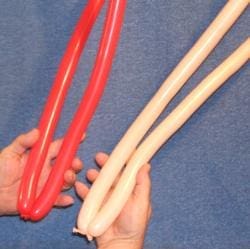

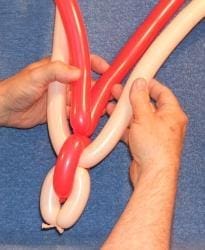

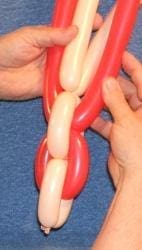
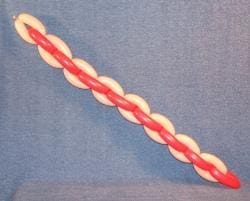
Heart From The Chain Link
Not only can you use that technique to make chains for shackles and anchors, but it can be used in the making an interesting heart design. Using two colors also allows for variety in making the heart. For the heart you will need two sets of chains which are the same length. At the top of both lengths of chain I bent and curved them slightly into a hook shape. You can get a more pronounced hook shape if you design the red (in my case) links a little lopsided as you are making them. In other words make the outside of the link slightly longer than the inside of the link.
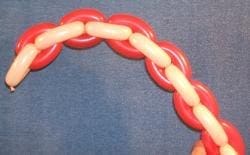
Connect the ends of both halves of the chain. At the top of the heart make a small blush loop and attach it through the two blush links as shown in the photo. I also added a couple of ear twists to help fill in the empty spaces. At the bottom I simply used a small scrap of red #160 and tied the two red links together.
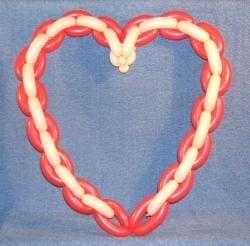
Balloon History
How did balloon twisting first get started? Art “Jolly the Clown” Petri states in his book, “Jolly,”Art Petri’s Course in Balloonology, which was copyrighted in 1975 how it began. Art says that Jay Marshall told him that the animal balloon mania was started by Herman Bonnert from Pennsylvania at a magician’s convention in 1939. Herman was in the novelty wholesale business. In 1939 I wasn’t born yet so I’m guessing that Herman twisted airship balloons into animal shapes. Joseph Maar says that his father, Henry Maar was doing a vaudeville act in Chicago around 1938-1939 where he made animals and apples from balloons. So who was first? I’m not sure.
According to early twister, Jim Church III, the first balloon sizes used to make balloon animals were the, #312, #338, #426, and #428. Balloon twisters were called by many names in the early days. Some of the terms were Balloon Sculpturist, Balloon Artist, Balloonologist, Balloonatic or Balloon Sculpturer. If you were a clown who twisted balloons you might be called a Balloontrixer. Balloon Workers typically did not twist balloons. Balloon Workers were venders who sold round balloons (on a stick or helium filled with an attached string), mouse head or the very long and large “worker” balloons. Slim Jim balloons are a type of worker balloon.
Back In 1975
It was 1975 when I first began learning how to make one-balloon sculptures. I’d like to share how things were in those days. I first noticed balloon animals at a magic shop in Pasadena, TX. They sold a small amount of twister books along with Ashland “Toy Time” balloons. I bought a book and a box of #245 “animal balloons”. When I first got started, the Ashland balloons came in a cardboard box containing a gross (144) of balloons. I had to learn to inflate them by mouth, because balloon pumps weren’t common then. Since I struggled with the inflation process, I ended up buying a tire pump (manually operated) and rigged a suitable nozzle so that I could inflate the balloons. Later I discovered that there were a few pasteboard (cardboard) balloon pumps for round balloons on the market and some large metal (about 3″ diameter by about 18″ long) balloon hand pumps. Those pumps had a stepped tapered nozzle. That way a variety of balloon sizes (mostly round) would fit snuggly on them. Back in 1975, there were no plastic hand pumps just for pencil balloons let alone double-action pumps. Some of the early twisters like Jim Church III had bellow style foot pumps purchased from the J. C. Christian Mfg. Co. Jim told me that he bought his pump in 1958.
Conventions
Marking Pens
Since saving time was one of the main goals for the early twisters doing “line” work, not all of them would use a marking pen to decorate the face. However, some of the early twisters did decorate their creations. It took some testing to find a suitable marker. To our surprise, we discovered that some of the inks used in marking pens would actually burst balloons. Before long however, most twisters settled on the Sanford “Sharpie”? and it became the pen of choice.
Odd Philosophy
One odd thing that I remember from the early days was encountering a few twisters who thought that I was doing balloons all wrong. Their opinion was that it wasn’t true balloon sculpturing if you used a pump or if you used a marking pen. Accordingly to them, inflating by mouth added moisture to the balloon which somehow made it better. I don’t know where that philosophy came from. But I was curious to find out if there was something to it. So I tried twisting dozens of balloon that had been mouth inflated against dozens that had been pump inflated. I found no difference. At any rate, I haven’t heard that philosophy in about 20 years, so it looks like it may have died out. My opinion is that if adding a few marks on a balloon makes it look better or if it gives it a personality, then why not do it? After all, who are we trying to please, the person receiving the balloon or some type of balloon police?
Sweeps
I never did got a chance to visit the Ashland Rubber company’s plant while they were in business. But I understand that most of their pencil balloons were made by hand. Less than half of their operation was automated. At any rate, at the end of the day there were lots of balloons laying on the floor. Some had imperfections like a bad nozzle and were tossed out and some just accidentally fell to the floor. These balloons, called “Sweeps”, were swept up at the end of the day. They got bagged up and sold as “practice” balloons. I don’t think that “Sweeps” were common knowledge, because some of the older twisters that I talked to had never heard about them.
Balloon Types
The first mass produced balloons were the round and the airship balloons. The airships were named because they looked like dirigibles or blimps. The first twister balloon size that I remember was the #245 balloon. When fully inflated, the #245 would measure about 2 inches in diameter and about 45 inches in length. They were referred to as “pencil” balloons because of their uninflated size. Other pencil balloon lengths that were around in the early days were the #236, #250, #260, and the #280. Eventually the #260 became the standard because its length was the most practical. There were several balloon companies in the early days like Adair, Mohican, Tuf-Tex, Oak Rubber and Toy Time. Toy Time (made by Ashland Rubber Products Company) was the leading balloon company in 1975. Jim Church III was the guy who gave us the modern pencil balloon. He didn’t invent it, but he was instrumental in getting it to the marketplace. At some point before 1962, Oak Rubber started making pencil balloons. However they were very thin. In fact, when inflated, their color almost vanished. Jim saw their potential so he bought a special run of 5000 red balloons made with thicker walls. He wanted to match the thicker walled round and airship balloons that were being used to make large animal balloons. The people at Oak Rubber thought Jim must be crazy and wondered how he could inflate them. Soon Jim was buying other color runs of the thicker Oak Rubber pencil balloons. The thicker pencil balloons caught on because Ashland Rubber Company started making them around 1964 when a magician from Toledo Ohio took them a bag of balloons Jim had gotten made at Oak Rubber.
In their heyday Ashland Rubber Company produced several different grades of #260 pencil balloons. Their wall thickness varied while keeping the same length and width. The normal grade balloon was the #260A. It had average thick walls. A slightly thicker walled pencil balloon was the #260E or Entertainer grade. The extra thickness of the #260E gave twisters less breakage during intense twisting. However the balloons took a little more effort to twist into shapes. The thickest walled pencil balloon was the #260EI. It was almost impossible to inflate them by mouth. Your hands got tired fairly quickly when you twisted them for any length of time. Ashland also made some specialty pencil balloons like the #260W (Whirly Bird Spinner) balloon which had a thicker strip of latex down the length of one side. That caused the balloon to inflate automatically into a spiral. It was interesting, but not too practical. That is, unless you always wanted your balloons to inflate into a spiral. Another interesting specialty pencil balloon was the Ashland #260P (Painted). It was a white pencil balloon painted with variegated colors. It looked great uninflated. But when inflated, the colors washed out and became a little bit dingy looking. The #260P fell by the wayside too. Another odd Ashland balloon was the #260C which inflated straight except for curve at the very end. It looked like a cane. The #260C also fell by the wayside. I had my own way of keeping track of the various Ashland “Toy Time” balloons. I remembered them this way. The #260A had Average thick walls. The #260E had Extra thick walls. The #260EI was an Extra thick Industrial grade balloon. The #260P was Painted and the #260W was a Whirly balloon. Sometimes other balloons were used by twisters. Ashland also made an Apple balloon. It was basically a small #312 airship with a dark green colored nipple end. They came in apple colors of red, green and yellow. The colored nipple end was round. When they were fashioned into an apple, the colored end became the stem. When Ashland introduced the #321 Bee Body balloons they also had a colored nipple end. Because the nipple end was long and tapered, it actually made a better looking apple than did the Apple balloon.
Twisting Back Then
Back around 1975, twisters took a minimal amount of equipment and supplies with them when they did “line” work. The typical twister carried assorted colors of pencil balloons, a black marking pen, a small pair of scissors and if they couldn’t inflate balloons by mouth, a hand pump. Sometimes they would also carry the #321 Bee Body balloons which were mostly used in making bees when combined with a pencil balloon. Apples were made from them as well. Twisters often kept their balloons in a carpenters nail apron or if they were dressed as a clown, they might simply stuff the pencil balloons into their big pockets. Keeping colors separated wasn’t very important in those days since most kids were happy to get a balloon animal even if it was made with a non-traditional color.
Because many people learned how to twist from books in the early days, twisters would make Joe La Monica’s clown, Roger Siegel’s gorilla or Jimmy Davis’ poodle. In other words, ideas from top twisters learned from their books.
One-balloon sculptures were the goal in those days when it came to “line” work. You had to work fast, so using only one balloon made sense. Besides, using one balloon was more economical than using two or three. Most stage shows in the early days used multiple balloons to make creations. In order to be seen better by the audience, the larger airship sizes were used.
Today twisters have more balloons and colors to pick from, more DVD’s to watch and more balloon related conventions to attend. So if a person has some natural talent, it is possible to pick up the art and get fairly good in a year or so. My, haven’t we come a long way!
I was tempted to finish this article with “The End”. But actually it’s not “The End”. I think we have only just begun to see advances in the art of balloon twisting.